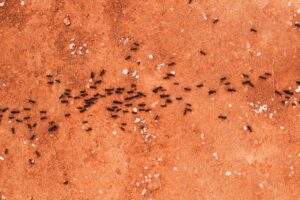Enjoy the Summer while Reducing Your Exposure to Pesticides
By Kathy Attar, Program Manager, Eco-Healthy Child Care®
July 2023
Science has brought to light many negative health and environmental impacts of pesticides.
Summer is a time for outdoor activities and enjoying the warm weather. However, it is also a time when pesticides are widely used in landscaping and in and around homes and child care facilities. In this blog post, we will discuss the dangers of pesticide use and provide tips for controlling pests using safer methods.
Pest control methods have been used for thousands of years. However, the 20th century was the first time mass-produced synthetic pesticides were used on a large scale.
Pesticides are chemicals that kill or control pests, such as insects, weeds, and rodents. Their use can have harmful health and environmental impacts. Pesticide exposure occurs by breathing it, ingesting it through the mouth, and via absorption through the skin or eyes. These harmful chemicals can be found in our food, our air (e.g., pesticide drift from agricultural uses and spraying of parks, areas around homes, schools, and child care facilities), and water (e.g., pesticides can enter our groundwater and surface water via contaminated soil). Pesticides can also be tracked into homes or child care environments on shoes and clothing.
Exposure to pesticides can have serious health impacts, including:
- Cancer: leukemia, lymphoma, and brain tumors;
- Reproductive and developmental problems: birth defects, miscarriages, and infertility;
- Neurological damage: damage to the nervous system, leading to symptoms such as headaches, dizziness, and seizures;
- Respiratory problems: lung irritation causing respiratory problems, such as asthma and bronchitis; and
- Skin and eye irritation: skin and eye irritation, rashes, and blisters.
Pesticides can also have harmful environmental impacts, including poisoning wildlife, contaminating water, killing beneficial insects (e.g., bees and ladybugs, which are important for pollination and natural pest control), and building up in the environment over time, leading to long-term contamination.
Safer Methods for Controlling Pests
Fortunately, there are safer methods for controlling pests. Here are some tips:
- Use least-toxic Integrated Pest Management (IPM) techniques to get rid of pests.
- IPM practices include only allowing children to eat food in the designated meal areas; limiting the use of food items for crafts and always storing food items in tightly sealed glass or metal containers; fixing all leaks promptly; and sealing or caulk cracks and holes.
- Choose a pest control professional that uses the least-toxic alternatives to control pests.
- Ask friends and family to recommend a pest management professional that employs mechanical methods first (e.g., caulking entranceways) for controlling pests.
- Ask the professional to inspect the site of concern. The inspection should include a written diagnosis of the problem or an identification of the pest.
- Confirm that baits and traps are used rather than sprays/foggers.
- Review the solutions. For example, a pest management professional who shares that they will spray every month is not a long-term solution.
- If you must use pesticides, at a minimum, there should be a 12-hour window between the application of pesticides and the time children are in the area (see manufacturer’s instructions to ensure 12 hours is enough time), and do not allow nap areas, play areas, or toys to be contaminated (pesticide residue can linger).
Reduce your exposure to pesticides in food by choosing organic produce whenever possible–especially for fruit and vegetables that contain higher amounts of pesticide residues.
Pesticide use can have harmful health and environmental impacts. Using safer methods for controlling pests, we can protect ourselves, our families, and the environment.







